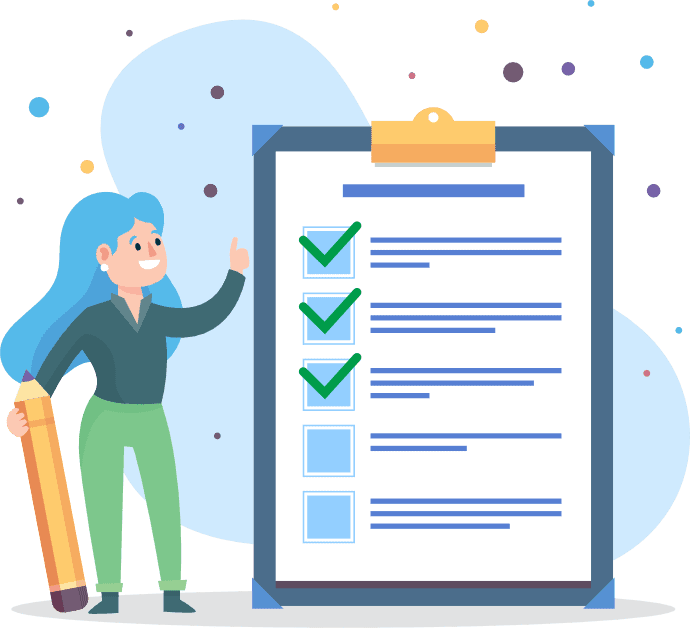Wondering why you need a no responsibility disclaimer for your business, and how to create one? Then you’re on the right page.
But before we go any further, I have a disclaimer to make.
“I am not a lawyer but I work with legal practitioners to ensure I provide the best value to readers. This article is only for informational and educational purposes. The disclaimer examples from third-party sites are also for educational purposes only. I am not liable for any damages resulting from the use of the information”.
See what I did there?
You just read a simple no-responsibility disclaimer that helps take the blame off us if you misuse the information in the article.
Contrarily, the disclaimer makes you trust us more. You trust me for being straightforward and honest (that I am not a lawyer).
This is just one of the many benefits of having a no-responsibility disclaimer.
Whether you run a blog, an eCommerce store, a consulting firm, an online course, or any other small business, you need a disclaimer.
And in this article, I’ll walk you through how to write one. Let’s get into it.
- With a no responsibility disclaimer, you can protect your business from legal action by clarifying that you’re not liable for any damages resulting from product use or information on your site.
- It is a valuable tool for fair and transparent interactions because it limits your liabilities regarding product misuse and prevents avoidable lawsuits.
- You need a no responsibility disclaimer when offering products or services with inherent risks, such as educational content, general advice, or entertainment purposes. It should be displayed where it is easiest to find.
Table of Contents
PRO TIP: Take the hassle of writing your own disclaimer away with our disclaimer generator trusted by over 200,000 businesses. It’ll save you hours of work and possible costly legal mistakes.
What Is a No Responsibility Disclaimer?
A no responsibility disclaimer is a type of disclaimer that explains that your business is not responsible for any damages that result from using your products or services or any information provided on your website or app.
It comes in handy in protecting your business against any legal action that might be brought against you. While it is not a foolproof way to stay out of court, it still a good idea to include a no responsibility disclaimer to prevent minor and harmful claims.
The Two Main Benefits of a No Responsibility Disclaimer for Your Business Are:
- Limits your liabilities from users misusing your products or information on your site: If you sell physical products, a disclaimer informs customers that they are responsible for how they use those products. Your business cannot be held responsible for any damages or injuries caused by using the products.
- Prevents avoidable lawsuits: Let’s say someone followed an exercise routine they saw on your fitness blog but, in the course, suffered injuries. The person will most likely not want to sue because their claim won’t hold water.
It’s important to note that a no responsibility disclaimer does not apply to just fitness trainers but to all small businesses. In later sections, you’ll find examples of no responsibility disclaimer for services, blogs, coaches, eCommerce stores, and local small businesses.
Why Do You Need a No Responsibility Disclaimer?
A no responsibility disclaimer is needed to clarify that the information provided is for general purposes only and to absolve the provider of any legal or personal responsibility for potential consequences.
Here are the specific reasons why you need one:
- Legal Protection: Shields the provider from legal liabilities and potential lawsuits arising from the use or interpretation of the information.
- Information Accuracy: Acknowledges that information may not be exhaustive, current, or error-free, reducing the risk of legal action due to inaccuracies.
- Individual Decision-Making: Encourages users to independently assess and verify information, emphasizing that the content is not a substitute for personalized professional advice.
- Changing Circumstances: Recognizes that circumstances, laws, or regulations may change, and the provider cannot guarantee immediate updates or accuracy in real-time.
- No Professional Relationship: Clarifies that the information does not establish a professional relationship, preventing misconceptions about the nature of the interaction.
- User Accountability: Reminds users of their responsibility to seek professional advice tailored to their specific situation and to use the information at their own risk.
In other words, a no responsibility disclaimer serves as a valuable tool for risk management, user protection, and building a strong foundation for fair and transparent interactions.
When Do You Need a No Responsibility Disclaimer?
A no responsibility disclaimer is needed whenever you offer a product or service that carries inherent risk or potential for misuse.
Here are some specific examples of when you might need a no responsibility disclaimer:
- Educational Content: When sharing educational materials, tutorials, or information where you don’t want to be held responsible for how users apply the knowledge.
- General Advice: Providing general advice on topics such as health, finance, or legal matters where individual circumstances may vary, and personalized professional advice is necessary.
- Your Contributions on Platforms: On platforms where you contribute content (forums, blogs, etc.), to protect yourself from liability for user-generated information or advice.
- Entertainment Purposes: When creating content for entertainment purposes, ensuring that viewers understand it is not intended as factual or professional guidance.
- Product or Service Descriptions: When describing your products or services, especially if you cannot guarantee the accuracy or availability of the information in real-time.
- Your Informational Websites: On your websites that provide general information, news, or updates, where you cannot control the accuracy or timeliness of the content.
Of course, this is not a complete list. The need for a no responsibility disclaimer can vary depending on the specific circumstances and potential risks involved.
If you are unsure whether you need one, it is always advisable to get legal advice from a professional.
Must-Have Elements in a No Responsibility Disclaimer
While there is no one-size-fits-all for no responsibility disclaimer, here are four essential elements to include:
Content and Information
New information and knowledge keep popping up every day. This is why it is best to regularly update the content of your website to ensure it keeps up with current trends and information.
But despite your best efforts, you can’t always guarantee that all your content is recent and free from typographical errors. Your no responsibility disclaimer should warn your readers not to rely completely on your content.
Also, it should state that you will not be held liable should they decide to act upon the information provided and suffer damages. Having this element is very important, especially if you’re in a constantly evolving industry, such as finance, law, or medicine.
Third-Party Links
Most websites contain links to external websites to add more authority to their site and provide their readers with more information. Bloggers usually also share affiliate links to third-party websites.
Since it is impossible to control what other parties share on their platform, it’s important to have a disclaimer for third-party links.
This disclaimer should specifically mention that you will not be held liable for the content and hyperlinks contained on those third-party resources.
Technical Issues
Technical issues happen and often at the worst times. Your website can be exposed to malware or spam, causing it to malfunction. For this period, users might not be able to use your site or mobile app.
For that reason, many websites disclaim liability for any damages that occur from not being able to use their website or mobile app or access the materials that are on it.
Another common technical issue is errors in coding or malfunctions during routine maintenance. When this occurs, it may take your site offline or make it inaccessible to some customers.
This makes it important for your disclaimer to cover problems customers can be exposed to due to any technical fault.
You can include a statement in your disclaimer to limit your legal liability regarding viruses or malware that could infect a user’s computer after visiting your website.
Feedback and Comments
This part of a disclaimer relieves you and your brand from possible violations due to what other users post on your platform.
You should think of your platform as a marketplace for people and ideas. People share reviews and testimonials or casually comment on your posts. These comments and feedback may breach specific regulations, or other users may simply find it offensive.
Hence, it becomes necessary to protect yourself and your brand from such information just as you do for the information you provide.
No Responsibility Disclaimer Examples You Can Learn From
Your no responsibility disclaimer should be as detailed as possible.
The details will depend on the nature of your activities, your type of audience, the risks associated with your business, and the type of content you share.
As promised, here are a few real-life examples of no responsibility disclaimers:
Medical Disclaimer
This is for health, fitness, and medical blogs. It is usually a clear statement that tells readers that the information provided should not be substituted for expert medical advice.
Health and fitness blog, Max Health Living, shares a medical disclaimer that states its content is for informational purposes only and isn’t intended to replace professional medical advice.
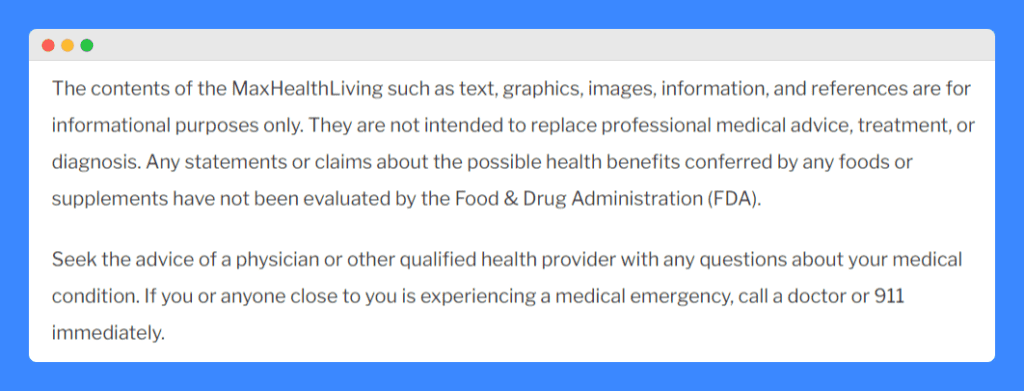
In a nutshell, adding a website liability disclaimer strengthens your credibility and makes your clients trust you more.
Local Small Businesses’ Disclaimer
For brands in this category, their disclaimer is usually straightforward. A good example is Edge Prime Energy. Their disclaimer of liability covers things like contact information, technical issues, and third-party links.

Investment Disclaimer
This is for finance, real estate, or retirement niche blogs and startups. It lets your readers know that while you provide financial advice based on personal insights and experience, you are not responsible when readers act on it.
MyWallSt, a financial and investment platform, advises readers to use its information as a starting point and do more research into companies and investing techniques.

Coaches and Consultants’ Disclaimer
Online coaches and consultants usually emphasize that clients are voluntary participants in their programs. The disclaimer covers legal, financial, medical, and religious purposes.
It also includes a performance disclaimer that tells prospective clients that past results do not guarantee future results. Even the best surgeon cannot guarantee success for all surgeries despite a track record of successful operations.
In other words, you can’t always guarantee new clients the same success you had with previous clients. So, ensure your disclaimer covers all bases.
Coach With Clarity is a typical example of a consultant disclaimer covering all the right bases.

eCommerce Store Disclaimer
eCommerce stores usually have their disclaimer of liability as one of the clauses in their terms and conditions. Online wine and gift shop, Vinebox, does just that with their limitation of liability clause. It covers loss due to damages and technical faults or malware.

Where to Display a No Responsibility Disclaimer?
To maximize effectiveness, it’s important to display your no responsibility disclaimer where users can easily find and read it.
Since it’s your way of setting clear boundaries and managing expectations when sharing information or offering services, it should be easy to find.
To give you an idea, here are key locations for different platforms:
Websites
Putting the disclaimer in the T&Cs section offers a comprehensive overview of your website’s legal terms and limitations. In the example below, Lifehack.org’s T&Cs clearly outline limitations regarding user-generated content and the site’s information accuracy.
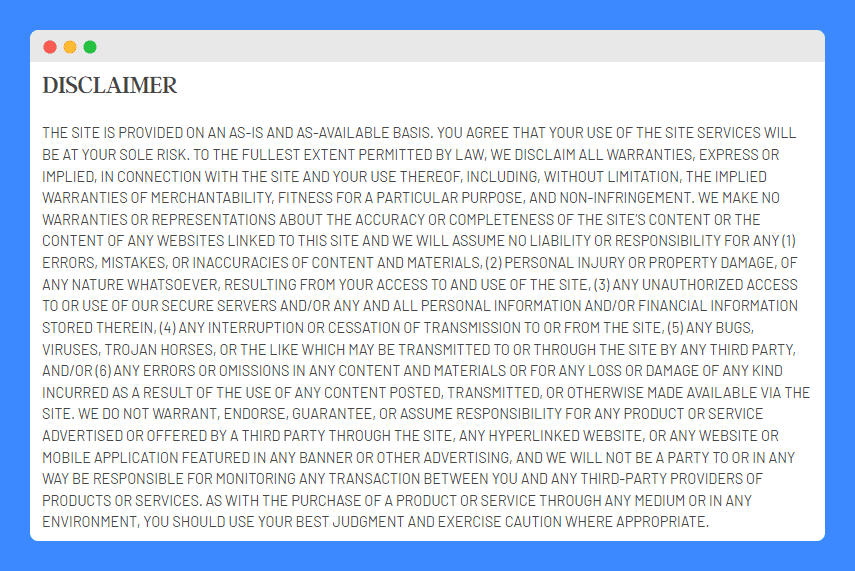
Basically, Lifehack.org says their site comes as it is, and if you use it, it’s your responsibility.
They dont guarantee anything and won’t be responsible for errors, injuries, or problems that might happen while you’re using the site or dealing with ads from other companies.
Mobile Apps
Similar to adding a legal disclaimer on your website, including one within the app’s TOS provides a centralized location for users to access key limitations and disclaimers.
For example, TED’s TOS clearly outlines limitations regarding content ownership and user conduct within the app.
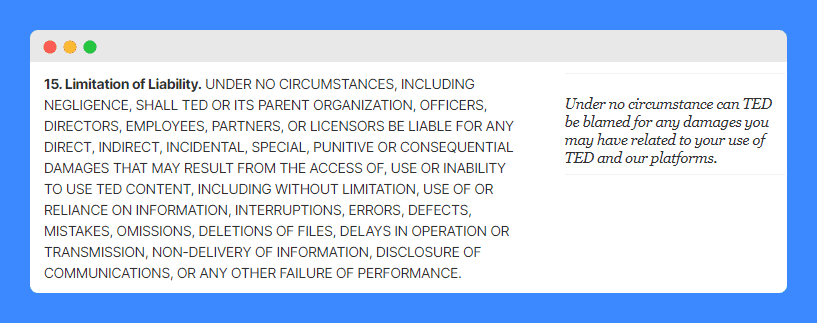
Like Lifehack.org, TED.com says they’re not responsible for any problems you might have using their content, even if it’s because of mistakes or delays. They won’t be liable for any damages that result from using their site, so use it at your own risk.
Blog Posts
For blogs with extensive content or complex disclaimers, you may want to create a dedicated section specifically outlining limitations and disclaimers. This provides a clear and concise reference point for users seeking clarity.
Check out this example from Entrepreneur.com’s blog post:

This disclaimer protects Entrepreneur.com from legal and financial liability by clarifying that the article’s information is not a substitute for professional advice. Instead, readers must seek guidance from qualified individuals.
Video Descriptions
The description box below your video is a readily available location for viewers to access key disclaimers without disrupting their viewing experience. This is particularly important for videos with potential risks or limitations.
Here’s an example:

This is from Doctor Mike’s YouTube video titled 10 Natural Remedies That Actually Work. It helps protect Doctor Mike from any legal liability if someone is harmed after following his advice.
Want to avoid legal trouble from your emails? Adding a no responsibility disclaimer in emails protects you from legal liability if someone is harmed by the information you send.
It also clarifies that you’re not offering professional advice.
Here’s an example:

Social Media
A no responsibility disclaimer in a social media bio or post caption helps clarify that the content shared is personal opinion or expression, reducing potential legal liabilities.
It also emphasizes that the user does not endorse or take accountability for any unintended consequences or misinterpretations of their content.
Here’s an example:
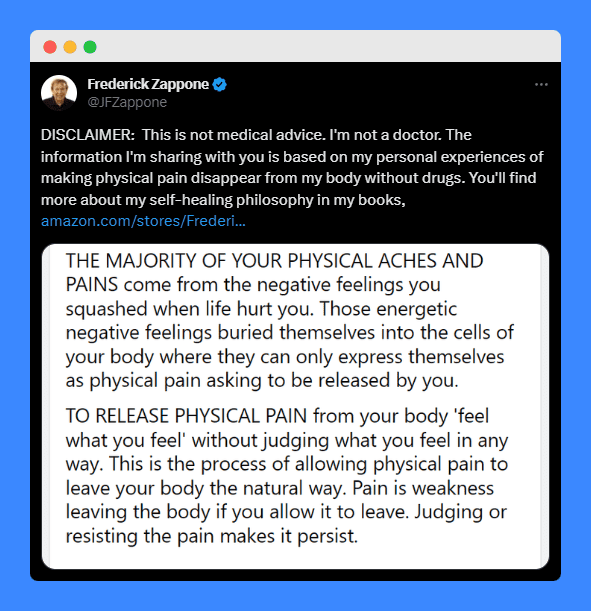
Waivers/Release of Liability Forms
Putting the disclaimer within the waiver or release form ensures users are fully aware of potential risks and limitations before engaging in the activity or service.
Requiring them to read and acknowledge the disclaimer before signing protects both parties involved.
Here’s what that looks like:
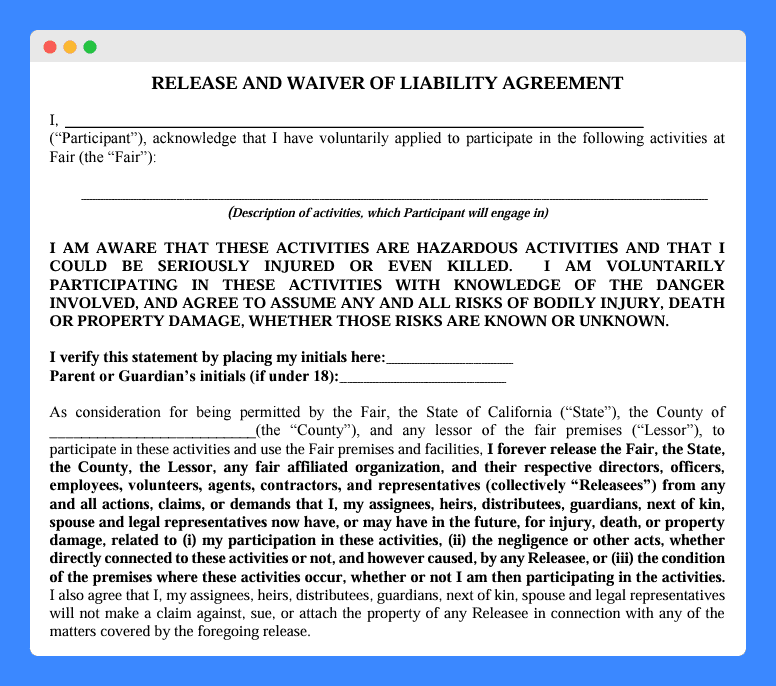
Forums
Clearly outlining limitations and user responsibilities within the forum rules and guidelines establishes expectations and helps prevent misunderstandings.
At the same time, it helps ensure a safe and enjoyable experience for all forum members.
Here’s an example:

Sample No Responsibility Disclaimer Template
Here’s a generic no responsibility template you may use as a head start when writing your own. Don’t forget that it’s just an example and it’s best to include other topics relevant to your business within your disclaimer for the proper legal protection.
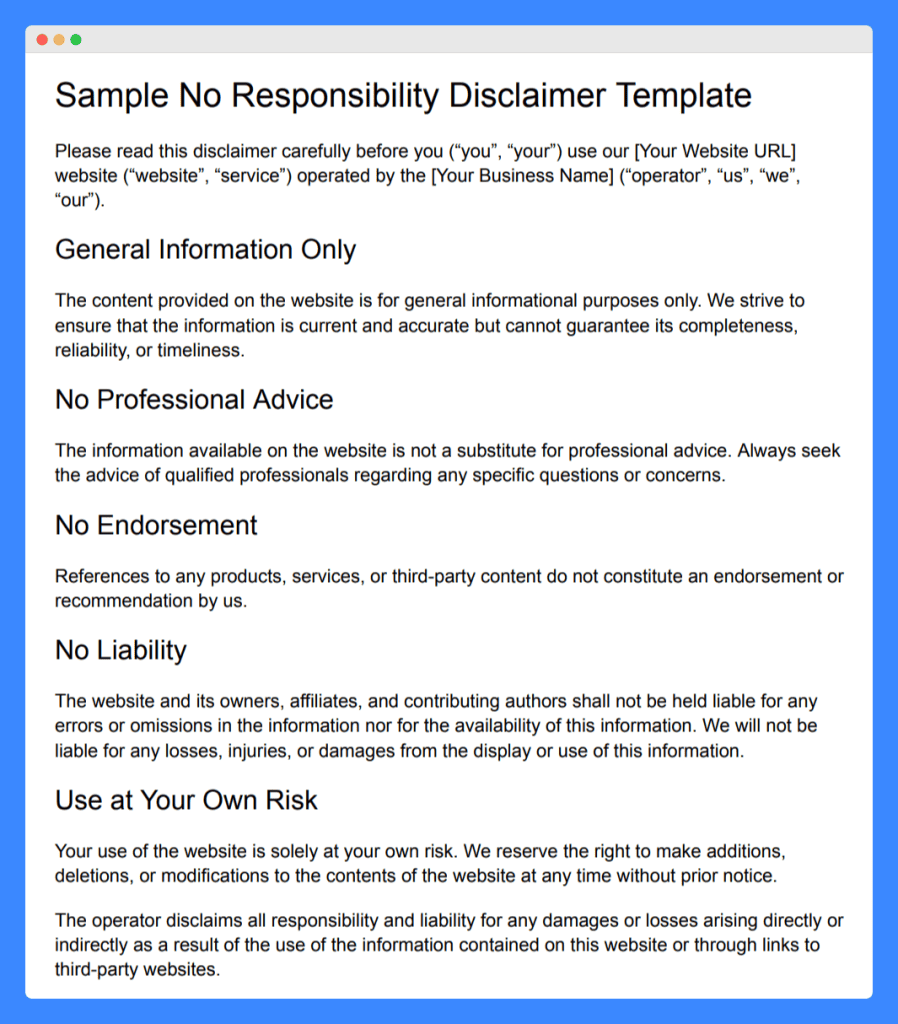
How to Create a Personalized No Responsibility Disclaimer
If reading or writing legal documents stresses you out, especially when it comes to creating a disclaimer for your website, consider using a professional disclaimer generator.
Our generator will automatically combine all the necessary components according to your needs and specifications. It will also ensure that everything remains up to date with the constantly evolving laws, relieving you of any worries or burdens.
Frequently Asked Questions
What is a liability disclaimer? Is it the same as a no responsibility disclaimer?
A legal liability disclaimer serves the same function as a no responsibility disclaimer and is also known as a disclaimer of liability or a no-liability disclaimer.
Why do I need a no responsibility disclaimer?
It keeps you and your business from being held responsible for damages from using your website, products, content information, or mobile app.
Do I still need a warranty disclaimer after a no responsibility disclaimer?
Yes, if you sell a product or offer information as a service. A warranty disclaimer relieves you from damaged products or inaccurate information on your platform.
Is a disclaimer the same as terms and conditions?
No, they serve different purposes. Although many people use them interchangeably, they are different documents. Terms and conditions are policies to regulate and guide users’ interaction with your business platforms. A disclaimer is there to protect you from legal claims by limiting liabilities.
Can I copy someone else’s disclaimer?
We do not recommend that you copy someone else’s disclaimer. Other disclaimers might not fully represent your business, exposing you to legal liabilities. The best option is to write your own tailor-made disclaimer. You can also use a disclaimer generator tool to draft the right one for your needs.

